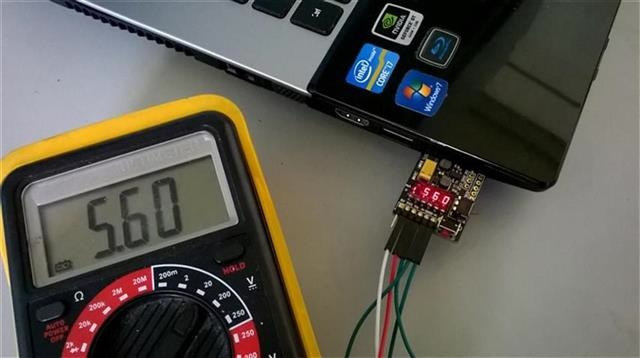Yesterday, I found out about a cheap 5V/3.3V USB power supply board, YwRobot MB-102, selling for $1 shipped on Ebay, but one person lamented the lack of 1.8V output, which may be required for example for modules like AsiaRF AWM002 that takes both 3.3V and 1.8V. One way is make your own power board, and get an expensive lab power supply, but I got a solution in my inbox this morning, with USBminiPower, as tiny USB power supply board with three output: 5V, 3.3V and a variable pin between 1V and 14.3V, as well as a 4 digit LED display showing the voltage and intensity just like Charger Doctor.
- MCU – Microchip PIC16 MCU (several are supported)
- Voltage outputs – 5V (from USB port), controllable 3.3V, and controllable & adjustable 1V … 14.3V
- Display – 4 Digit red LED to display intensity and voltage
- Max Power – 2.45 Watts
- Headers – ICSP header for uploading firmware, 3-pin for future expansion
- Misc – Rocker switch to increase or decrease voltage for the adjustable pin. Button to enable/disable output.
- Dimensions – 31x26mm
You just need to connect it to one of the USB port of your computer to use it. The variable pin voltage is controlled via the rocker switch. If the project is successfully funded the firmware source and hardware design files will be released. To modify the firmware yourself, you’ll need Pickit3 or ICD3 in-circuit debugger, and MPLabX installed on your computer.
 The developer listed the project on Kickstarter where he aims to raise £5,000 or more. Rewards start at £6 (~$9) for a bare PCB, and up to £25 ($38) for a fully assembled board. Shipping is £1 to £5 extra depending on the reward and destination country, with delivery scheduled for June 2015 (Bare PCB) or August 2015 (Fully assembled PCB).
The developer listed the project on Kickstarter where he aims to raise £5,000 or more. Rewards start at £6 (~$9) for a bare PCB, and up to £25 ($38) for a fully assembled board. Shipping is £1 to £5 extra depending on the reward and destination country, with delivery scheduled for June 2015 (Bare PCB) or August 2015 (Fully assembled PCB).
Thanks to Atanas for the tip.

Jean-Luc started CNX Software in 2010 as a part-time endeavor, before quitting his job as a software engineering manager, and starting to write daily news, and reviews full time later in 2011.
Support CNX Software! Donate via cryptocurrencies, become a Patron on Patreon, or purchase goods on Amazon or Aliexpress





